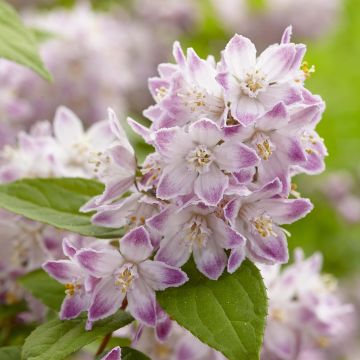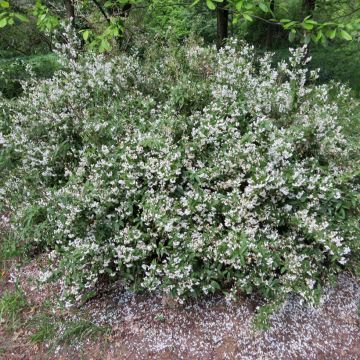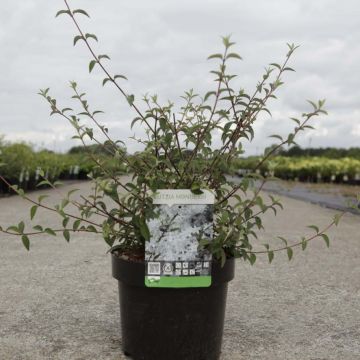

Deutzia scabra 'Punctata'
Deutzia scabra 'Punctata'
Deutzia scabra Punctata
Fuzzy Deutzia, Rough Deutzia, Pride of Rochester
This item cannot be shipped to the selected country
Delivery charge from €5.90
More information
Schedule delivery date,
and select date in basket
This plant carries a 24 months recovery warranty
More information
We guarantee the quality of our plants for a full growing cycle, and will replace at our expense any plant that fails to recover under normal climatic and planting conditions.
From €5.90 for pickup delivery and €6.90 for home delivery
Express home delivery from €8.90.
Does this plant fit my garden?
Set up your Plantfit profile →
Description
Deutzia scabra 'Punctata' is a variety of Deutzia appreciated for its beautiful variegated foliage. It forms a medium-sized bush. The prolific white spring flowering on beautifully arched branches adds a nice touch to a very ornamental foliage, as if splashed or marbled with grey and light green on a cream or dark green background. At the time of flowering, between the white flowers and the brightness of the foliage, the bush is studded with light. Like other Deutzias, it has vigorous growth and is fairly easy to cultivate as long as it is given the right starting conditions. It reaches its full potential in partial shade, especially since its delicate foliage prefers to avoid the assault of the scorching sun. Its reasonable size makes it suitable for all gardens, in deep, rich, and well-drained soil.
Deutzia scabra belongs to the Hydrangea family. This species is native to China and Japan, but is also found in Pakistan. This large-sized bush has an upright habit in its early years, which widens with age and reaches a height of 3 metres (10 feet) and a spread of 2 metres (7 feet) in adulthood. Its flexible branches slightly arch at their tips. Its bark, cinnamon in colour, peels off in adulthood. The 'Punctata' variety shows more modest growth, reaching 1.50 metres (5 feet) in all directions at maturity. It flowers in May and June in panicles of white star-shaped flowers. Its deciduous leaves are a fairly dark matte green, or cream-white, more or less splashed with light green and grey, giving some leaves a predominantly light colour, while others are predominantly dark green. They are oval-shaped, elongated lanceolate, measuring 4 to 7cm (2 to 3in) in length, and have toothed edges.
Deutzia scabra and its cultivars are very hardy, but they fear drought and shallow soils. It is necessary to protect the variegated foliage of 'Punctata' from the scorching sun and strong winds. It tolerates calcareous soils as long as they are deep, rich, and well-drained. This particularly ornamental bush can be planted individually in a small sheltered garden. In a flowerbed or a small free, flowering, or mixed hedge, it is associated with other shrubs with staggered flowering such as spireas, ornamental apple trees, Kolkwitzias. In front of a dark-leaved Elderberry, it offers a striking contrast. Similarly, evergreen shrubs with dark green foliage enhance its luminous foliage. Consider conifers, or Osmanthus burkwoodii for example.
Report an error about the product description
Plant habit
Flowering
Foliage
Botanical data
Deutzia
scabra
Punctata
Hydrangeaeceae
Fuzzy Deutzia, Rough Deutzia, Pride of Rochester
Cultivar or hybrid
Other Deutzia
Planting and care
Deutzia scabra 'Punctata' whilst accommodating in terms of soil and tolerating the presence of limestone, shows a preference for deep, moist, well-drained and humus-rich soils. It will appreciate a partially shaded exposure, sheltered from strong winds to protect its flowering and foliage. A fairly short pruning after flowering is recommended to clean it of all dead stems and floral branches and maintain its variegation.
Planting period
Intended location
Care
This item has not been reviewed yet - be the first to leave a review about it.
Hedge shrubs
Haven't found what you were looking for?
Hardiness is the lowest winter temperature a plant can endure without suffering serious damage or even dying. However, hardiness is affected by location (a sheltered area, such as a patio), protection (winter cover) and soil type (hardiness is improved by well-drained soil).

Photo Sharing Terms & Conditions
In order to encourage gardeners to interact and share their experiences, Promesse de fleurs offers various media enabling content to be uploaded onto its Site - in particular via the ‘Photo sharing’ module.
The User agrees to refrain from:
- Posting any content that is illegal, prejudicial, insulting, racist, inciteful to hatred, revisionist, contrary to public decency, that infringes on privacy or on the privacy rights of third parties, in particular the publicity rights of persons and goods, intellectual property rights, or the right to privacy.
- Submitting content on behalf of a third party;
- Impersonate the identity of a third party and/or publish any personal information about a third party;
In general, the User undertakes to refrain from any unethical behaviour.
All Content (in particular text, comments, files, images, photos, videos, creative works, etc.), which may be subject to property or intellectual property rights, image or other private rights, shall remain the property of the User, subject to the limited rights granted by the terms of the licence granted by Promesse de fleurs as stated below. Users are at liberty to publish or not to publish such Content on the Site, notably via the ‘Photo Sharing’ facility, and accept that this Content shall be made public and freely accessible, notably on the Internet.
Users further acknowledge, undertake to have ,and guarantee that they hold all necessary rights and permissions to publish such material on the Site, in particular with regard to the legislation in force pertaining to any privacy, property, intellectual property, image, or contractual rights, or rights of any other nature. By publishing such Content on the Site, Users acknowledge accepting full liability as publishers of the Content within the meaning of the law, and grant Promesse de fleurs, free of charge, an inclusive, worldwide licence for the said Content for the entire duration of its publication, including all reproduction, representation, up/downloading, displaying, performing, transmission, and storage rights.
Users also grant permission for their name to be linked to the Content and accept that this link may not always be made available.
By engaging in posting material, Users consent to their Content becoming automatically accessible on the Internet, in particular on other sites and/or blogs and/or web pages of the Promesse de fleurs site, including in particular social pages and the Promesse de fleurs catalogue.
Users may secure the removal of entrusted content free of charge by issuing a simple request via our contact form.
The flowering period indicated on our website applies to countries and regions located in USDA zone 8 (France, the United Kingdom, Ireland, the Netherlands, etc.)
It will vary according to where you live:
- In zones 9 to 10 (Italy, Spain, Greece, etc.), flowering will occur about 2 to 4 weeks earlier.
- In zones 6 to 7 (Germany, Poland, Slovenia, and lower mountainous regions), flowering will be delayed by 2 to 3 weeks.
- In zone 5 (Central Europe, Scandinavia), blooming will be delayed by 3 to 5 weeks.
In temperate climates, pruning of spring-flowering shrubs (forsythia, spireas, etc.) should be done just after flowering.
Pruning of summer-flowering shrubs (Indian Lilac, Perovskia, etc.) can be done in winter or spring.
In cold regions as well as with frost-sensitive plants, avoid pruning too early when severe frosts may still occur.
The planting period indicated on our website applies to countries and regions located in USDA zone 8 (France, United Kingdom, Ireland, Netherlands).
It will vary according to where you live:
- In Mediterranean zones (Marseille, Madrid, Milan, etc.), autumn and winter are the best planting periods.
- In continental zones (Strasbourg, Munich, Vienna, etc.), delay planting by 2 to 3 weeks in spring and bring it forward by 2 to 4 weeks in autumn.
- In mountainous regions (the Alps, Pyrenees, Carpathians, etc.), it is best to plant in late spring (May-June) or late summer (August-September).
The harvesting period indicated on our website applies to countries and regions in USDA zone 8 (France, England, Ireland, the Netherlands).
In colder areas (Scandinavia, Poland, Austria...) fruit and vegetable harvests are likely to be delayed by 3-4 weeks.
In warmer areas (Italy, Spain, Greece, etc.), harvesting will probably take place earlier, depending on weather conditions.
The sowing periods indicated on our website apply to countries and regions within USDA Zone 8 (France, UK, Ireland, Netherlands).
In colder areas (Scandinavia, Poland, Austria...), delay any outdoor sowing by 3-4 weeks, or sow under glass.
In warmer climes (Italy, Spain, Greece, etc.), bring outdoor sowing forward by a few weeks.























































